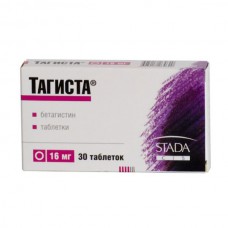Expiration date: 05/2026
The composition and form of issue:
Tablets. 1 tablet contains:
betahistine dihydrochloride 8, 16 or 24 mg
other ingredients: microcrystalline cellulose povidone (kollidon 25) potato starch citric acid silicon dioxide colloidal (Aerosil) talc magnesium stearate
in a contour acheikova packing 10 or 30 PCs or in a polymeric 30, 50 or 100 PCs per cartons 3 or 5 contour cell packs of 10 PCs., 1, 2 or 3 contour cell packs of 30 PCs or 1 Bank.
Description pharmaceutical form:
Tablets almost white or white with kremovatam white color, ploskotsylindriceskie, chamfered and mark.
Pharmacokinetics:
Absorbed quickly bond with plasma proteins is low. Tmax in plasma is 3 h.
Almost completely excreted by the kidneys as metabolites (2-pyridyloxy acid) for 24 h. T1/2 — 3-4 h.
Description pharmacological action:
Betagistin acts mainly on histamine H1 - and H3-receptors of the inner ear and the vestibular nuclei CNS. Through direct agonistic effects on H1-receptors receptacles inner ear, as well as indirectly through its effect on H3 receptors improves microcirculation and capillary permeability, normalizes pressure of endolymph in the labyrinth and the cochlea. However betagistin increases blood flow in the basilar artery.
Has a pronounced Central effect, affecting the H3-receptors of the nuclei of the vestibular nerve. Normalizes conductivity in the neurons of the vestibular nuclei at the level of the brain stem.
Clinical manifestation of these properties is to reduce the frequency and intensity of vertigo, reducing tinnitus, improve hearing in the case of lowering it.
Indications:
- treatment and prevention of vestibular vertigo of different origin
- syndromes, including vertigo and headache, noise in the ears, progressive hearing loss, nausea and vomiting
- disease or Meniere's syndrome.
Contraindications:
- hypersensitivity to any component of the drug
- the age of 18 years (due to lack of data)
- pregnancy and lactation (due to lack of data).
Caution: gastric ulcer or duodenal ulcer (including history), pheochromocytoma, bronchial asthma. These patients should be monitored regularly during treatment.
Side effects:
Gastrointestinal disorders, hypersensitivity reactions of the skin (rash, pruritus, urticaria), angioedema.
Drug interactions:
Cases interaction or incompatibility with other drugs is unknown.
Method of application and dose:
Inside, during a meal.
Tablets 8 mg: 1-2 tab. 3 times a day.
Tablets 16 mg: PO1/table 2-1. 3 times a day.
Tablets 24 mg: 1 tab. 2 times a day.
Improvement is usually already at the beginning of therapy, stable therapeutic effect occurs after 2 weeks of treatment and can grow within a few months of treatment. The prolonged treatment. The duration of treatment is determined individually.
Overdose:
Symptoms: nausea, vomiting, cramps.
Treatment: gastric lavage, reception activated carbon, symptomatic therapy.
Special instructions:
Influence on ability to driving and other mechanisms
Betagistin has no sedative effect and does not affect the ability to drive or engage in activities requiring speed of psychomotor reactions.




